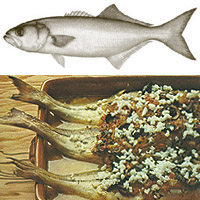Gluten Free
What does following a gluten-free diet mean? That you're embarking on an easy diet with a wide range of health-promoting effects. Instead of dwelling on what you’re giving up, consider that you’re going to enjoy a whole new world of delicious food options to meet your special dietary needs. You’ll be eating seasonally, choosing more fresh fruits and vegetables, focusing on meats, seafood, poultry, legumes, lentils, corn, and rice, and discovering fascinating ancient grains such as quinoa, amaranth, and millet. You’ll be able to eat potatoes, eggs, most cheeses, even chocolate (!)—and enjoy them without guilt because you’ll be taking good care of your body. In fact, you’ll probably end up eating—and feeling—better than ever!
Visit this page for more information about living Gluten Free
---
We carry a large variety of gluten free items, the brands listed below represent just some of the offerings we carry















More Diets
Bluefish

Preparation, Uses, & Tips
Scale the fish by placing it in the sink under cold running water. Grasp the fish firmly by the gills and scrape off scales with a fish scaler or small, dull knife. Using short strokes, work from the tail to the head.
To remove the head, first cut through the flesh on both sides with a sharp knife. Then, if the fish is small, slice directly through the spine. For a larger fish, place the knife between vertebrae and tap the back of the knife with a hammer.
To fillet, use a sharp, thin knife. With the bluefish lying on its side, insert the knife behind the gills, and cut in an arc down to just above the backbone. Continue cutting parallel to the backbone toward the tail. Bring the knife up at the tail and remove the fillet. To skin the fillet, place it on a board, skin side down. Run a thin, sharp knife along the fillet between the flesh and the skin.
The secret to successful bluefish cookery is to not overcook. Whichever of the following cooking methods you choose, your bluefish will be cooked when its flesh becomes opaque but is still moist and can easily be pierced with a fork.
Brining
To improve the texture of bluefish, marinate the fish in a mixture of kosher salt, herbs, and water. Bring the salt, water, and herbs to a boil, simmer five minutes, then let cool. Add ice, pour brining mixture over the fish in a glass or stainless steel container, and refrigerate for one hour. Drain and pat dry before cooking.
Baking
Rinse fish and pat dry with a paper towel. Place whole or filleted bluefish in baking pan and cover with sauce made of liquid, herbs and spices, and vegetables. Bake in the oven at 400°F (200°C) until a knife slice in the thickest part reveals the flesh to be opaque but still moist.
Grilling
Place whole small fish or fillets directly on greased grill, 4 to 6 inches (10 to 15cm) above prepared coals or fire. Baste with butter, oil, or marinade, and close hood of grill. Cook until opaque and moist on the inside, 6 to 8 minutes for fish less than one inch (2.5cm) thick; 10 to 15 minutes for fish larger than one inch (2.5cm) thick.
Broiling
Rinse bluefish fillets and pat dry with a paper towel. Place fish on a rack above a baking dish. Preheat broiler and adjust oven rack so fish is 3 to 4 inches (7.6 to 10cm) from the element. Broil, turning once, until fish is opaque but still moist in the center, 3 to 10 minutes, depending on the size of the fish.
Pan frying
Rinse bluefish and pat dry with a paper towel. Dredge in flour and seasonings if desired. Shake off excess flour. Heat frying pan until hot. Add butter or oil. Place fillets in the pan and cook, turning once, until opaque but still moist in the center, 2 to 10 minutes, depending on the size of the fish.
Copyright © 2025 TraceGains, Inc. All rights reserved.
Learn more about TraceGains, the company.
The information presented in the Food Guide is for informational purposes only and was created by a team of US–registered dietitians and food experts. Consult your doctor, practitioner, and/or pharmacist for any health problem and before using any supplements, making dietary changes, or before making any changes in prescribed medications. Information expires December 2025.











